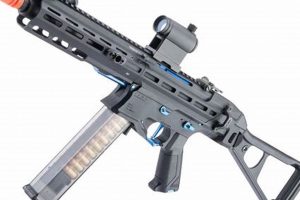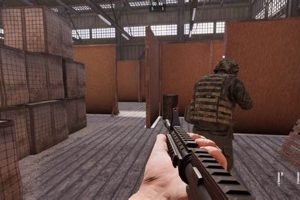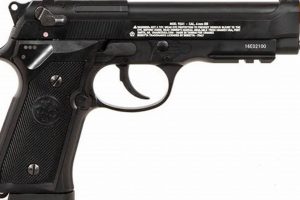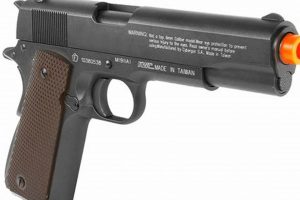The terminology refers to a type of airsoft replica firearm that utilizes gas to propel projectiles. This mechanism commonly employs compressed gases, such as propane or CO2, to cycle the action of the replica and discharge plastic projectiles, or BBs. A typical application involves simulated firearm training or recreational target shooting, where realistic operation is desired.
These gas-operated replicas offer a higher degree of realism compared to their electric or spring-powered counterparts. The simulated recoil and operational mechanics contribute to a more immersive experience. Historically, the development of these systems aimed to replicate the weight, feel, and operational characteristics of actual firearms, appealing to enthusiasts seeking a realistic training or simulation platform.
Further discussion will elaborate on the specific gas types utilized, the internal mechanisms responsible for operation, and the considerations involved in maintaining and optimizing these replica firearms for performance and longevity. Detailed analysis of common issues and repair techniques will also be presented.
Optimization and Maintenance Guidelines
The following guidelines address key aspects of operating and maintaining gas blowback airsoft replicas to maximize performance and extend service life.
Tip 1: Gas Selection: Employ the appropriate gas type as recommended by the manufacturer. Using excessively high-pressure gas can damage internal components, while insufficient pressure can result in cycling failures.
Tip 2: Regular Cleaning: Consistent cleaning of the internal mechanisms, particularly the barrel and gas chamber, is crucial. Accumulated debris can impede proper cycling and reduce accuracy.
Tip 3: Lubrication: Proper lubrication with silicone oil or grease, specifically designed for airsoft applications, reduces friction and wear on moving parts. Apply lubricant sparingly to avoid excessive build-up.
Tip 4: Magazine Maintenance: Inspect magazine seals regularly for leaks and ensure proper lubrication of the magazine valve. Leaky magazines result in gas wastage and inconsistent performance.
Tip 5: Storage: Store replicas with a small amount of gas in the magazine to prevent seal shrinkage and maintain pressure. Avoid prolonged storage in extreme temperatures, which can degrade seals and other components.
Tip 6: Hop-Up Adjustment: Optimize the hop-up unit for the weight of the BBs used. Incorrect hop-up settings negatively impact range and accuracy.
Tip 7: Disassembly and Reassembly: When disassembling for maintenance or repairs, document the process and use appropriate tools to prevent damage to delicate components.
Adhering to these recommendations contributes to consistent operation, improved accuracy, and prolonged functionality of gas blowback airsoft replicas.
Subsequent sections will explore common troubleshooting scenarios and advanced modification techniques.
1. Gas Efficiency
Gas efficiency in gas blowback airsoft replicas dictates the number of projectiles discharged per unit of gas. This is a critical performance metric directly impacting operational cost and practical usability. High gas consumption necessitates frequent refills, interrupting gameplay and increasing expenditure on compressed gas. Several factors influence the efficiency of a system, including the design of the internal gas routing, the quality of seals, and the operating pressure. A poorly designed or maintained gas blowback mechanism can exhibit significant gas leakage, resulting in reduced shot count and inconsistent performance.
Consider, for example, two otherwise identical gas blowback pistols. One with meticulously maintained seals and an optimized gas delivery path may achieve 30-40 shots per gas fill, while the other, suffering from seal degradation and a less efficient design, might only manage 15-20 shots. The practical implications are substantial: the former allows for sustained engagement during airsoft skirmishes, while the latter requires frequent pauses for reloading gas, potentially compromising tactical effectiveness. Furthermore, environmental factors, such as ambient temperature, influence gas pressure and, consequently, efficiency. Lower temperatures reduce gas pressure, leading to reduced shot count and lower projectile velocity.
In summary, gas efficiency is a paramount consideration in the selection and maintenance of a gas blowback airsoft replica. Optimizing this aspect not only reduces operational costs but also enhances overall performance and tactical utility. Addressing factors such as seal integrity, internal design, and environmental conditions is crucial for maximizing gas efficiency and ensuring consistent operation.
2. Recoil Simulation
Recoil simulation represents a pivotal aspect of gas blowback airsoft replicas, directly influencing the user’s perception of realism and the utility of these devices for training purposes. The gas-driven operation inherent in these systems provides the mechanism for simulating recoil, a physical reaction experienced in actual firearms. The release of compressed gas to propel a projectile simultaneously forces the slide or bolt of the replica to cycle, generating a backward impulse that simulates the recoil effect. The magnitude and characteristics of this simulated recoil are directly proportional to factors such as the gas pressure, projectile weight, and the design of the internal mechanism.
The presence, or absence, of convincing recoil significantly impacts the training value of gas blowback airsoft replicas. In scenarios where realistic firearm handling is paramount, such as force-on-force simulations or tactical training exercises, the recoil provides crucial feedback to the user, reinforcing proper grip, stance, and trigger control. For example, an individual training for competitive shooting may utilize these replicas to refine their recoil management techniques, ultimately improving accuracy and speed with live firearms. Furthermore, the simulated recoil adds a layer of immersion to recreational airsoft activities, heightening the sense of realism and enhancing the overall experience. A system with weak or nonexistent recoil may be deemed unsatisfactory by users seeking a high degree of verisimilitude. The simulated effect becomes vital in recreating the experience of handling a real firearm, which makes the airsoft equipment effective when used in training or practice scenarios.
In summation, recoil simulation constitutes a critical component of gas blowback airsoft replicas, serving both practical training purposes and enhancing the overall realism of the airsoft experience. Achieving an optimal balance between recoil magnitude, gas efficiency, and mechanical durability remains a central design challenge in the development of these systems. Advanced designs often incorporate adjustable recoil settings, allowing users to fine-tune the level of realism to suit their specific needs and preferences, further cementing recoil as a key characteristic of these training and recreational tools.
3. Realistic Operation
Realistic operation forms a cornerstone of the appeal and utility of gas blowback (GBB) airsoft replicas. This characteristic refers to the degree to which the replica emulates the functionality of a real firearm. Key aspects of realistic operation include a functional slide or bolt that cycles with each shot, a last-round bolt hold-open feature (where the slide locks back upon emptying the magazine), and a magazine that can be removed and reloaded. The significance lies in the fact that a greater degree of operational realism enhances both the training value and the user experience.
Consider the example of practicing firearm manipulations with a GBB airsoft replica. The realistic operation allows users to develop and reinforce muscle memory for tasks such as magazine changes, clearing malfunctions, and engaging targets from various positions. The need to rack the slide after inserting a fresh magazine, a feature common in real firearms, is replicated, promoting proper training habits. Furthermore, the weight and balance of many GBB replicas closely resemble those of their real firearm counterparts, contributing to a more authentic training experience. In airsoft skirmishes, realistic operation adds a layer of immersion, requiring players to manage their ammunition and employ tactical reloading techniques.
In summary, the emphasis on realistic operation distinguishes GBB airsoft replicas from other types. This focus results in training tools that improve user skill and practice, and also enriches recreational airsoft gameplay. The development of GBB technology continues to strive for even greater fidelity in replicating the operational characteristics of real firearms, addressing challenges such as improving gas efficiency and durability while maintaining a high degree of realism.
4. Material Durability
Material durability is a critical factor influencing the longevity and performance of gas blowback (GBB) airsoft replicas. The internal mechanisms of these systems are subjected to repetitive stress from the cycling of gas and the movement of internal components. The materials employed in their construction directly determine the system’s ability to withstand these stresses and maintain functionality over time. Substandard materials will result in premature wear, breakage, and a reduced lifespan for the replica. For example, using a low-grade zinc alloy for the slide of a GBB pistol may lead to cracking or deformation under the repeated force of the gas blowback action. This, in turn, will cause malfunctions, reduced accuracy, and eventually, the need for costly repairs or replacement.
Conversely, GBB replicas constructed with high-grade materials, such as reinforced polymers, steel, and aircraft-grade aluminum, exhibit significantly greater resistance to wear and tear. The enhanced durability translates to increased reliability and a longer service life, even under demanding conditions. Consider a GBB rifle with a steel bolt carrier and a reinforced polymer receiver. These components can withstand the high pressures and rapid cycling associated with sustained use, ensuring consistent performance and minimizing the risk of component failure. Material selection directly influences the price point of airsoft GBB products, as higher-grade materials often carry a higher cost. However, this increased upfront investment can prove to be more cost-effective in the long run, avoiding frequent repairs or replacements.
In conclusion, material durability constitutes an essential aspect of GBB airsoft replicas, directly impacting their lifespan, reliability, and overall value. Manufacturers prioritizing the use of high-quality materials offer products that deliver superior performance and require less frequent maintenance. Understanding the importance of material composition enables informed purchasing decisions, ensuring that the user invests in a replica capable of withstanding the rigors of regular use. The selection of appropriate materials presents an ongoing challenge in the airsoft industry, as manufacturers strive to balance durability, performance, and cost-effectiveness.
5. Internal Mechanism
The operational characteristics of a gas blowback (GBB) airsoft replica are fundamentally dependent on its internal mechanism. This mechanism, a complex arrangement of interconnected components, regulates the flow of gas, controls the movement of the slide or bolt, and initiates the propulsion of the projectile. The design and functionality of this mechanism directly dictate performance parameters such as gas efficiency, recoil simulation, and the overall reliability of the replica. The internal mechanism’s effectiveness is the cause of gas efficiency, realistic action, and overall effectiveness. Poor design will lead to leaks, malfunctions, and unrealistic performance.
Consider the example of a GBB pistol. Upon trigger activation, a valve releases a metered amount of compressed gas from the magazine. This gas expands rapidly, driving the projectile down the barrel and simultaneously forcing the slide rearward. The slide’s rearward movement cocks the hammer, extracts the spent cartridge, and prepares the replica for the next shot. A return spring then propels the slide forward, stripping a new BB from the magazine and chambering it. This entire cycle is orchestrated by the precise interaction of various internal components, including the valve, hammer, sear, nozzle, and recoil spring. Failure of any single component can disrupt the entire firing sequence. For example, a worn-out valve seal will leak gas, resulting in reduced power and inconsistent cycling. This emphasizes the need to understand and maintain the internal components to ensure functionality.
In summation, the internal mechanism forms the core of the GBB airsoft replica, underpinning its operational functionality and dictating its performance characteristics. A thorough understanding of this mechanism is crucial for effective maintenance, troubleshooting, and performance optimization. Addressing malfunctions and optimizing the internal mechanism are vital to the performance of any GBB system. The development of robust and efficient internal mechanisms continues to drive innovation in the airsoft industry, resulting in replicas that offer improved realism, enhanced performance, and increased reliability.
Frequently Asked Questions
The following questions address common inquiries and misconceptions surrounding gas blowback (GBB) airsoft systems, providing concise and informative answers.
Question 1: What gases are compatible with systems?
The gases utilized typically include propane (with silicone oil additive), CO2, and specialized airsoft gases such as green gas or red gas. The appropriate gas depends on the specific replica and the manufacturer’s recommendations. Utilizing incorrect gases can damage internal components.
Question 2: How often requires cleaning and maintenance?
The frequency of cleaning and maintenance depends on usage. Regular cleaning after each skirmish or prolonged use is advisable. Periodic lubrication of moving parts and inspection of seals are essential to ensure proper operation and longevity.
Question 3: What is the effective range and accuracy?
Effective range and accuracy vary depending on the replica’s design, the quality of the internal components, and the ammunition (BBs) used. A well-maintained system with a properly adjusted hop-up unit can achieve ranges of up to 150-200 feet with reasonable accuracy.
Question 4: What are common malfunctions and troubleshooting?
Common malfunctions include gas leaks, failure to cycle, and inconsistent projectile velocity. Troubleshooting often involves inspecting seals, lubricating moving parts, and ensuring proper gas pressure. More complex issues may require disassembly and replacement of worn components.
Question 5: Are modifications and upgrades available?
Numerous modifications and upgrades are available for gas blowback systems, including enhanced barrels, hop-up units, and internal components designed to improve performance, accuracy, and durability. However, modifications should be performed by experienced individuals to avoid damaging the replica.
Question 6: How to store to maximize the life of the product?
To maximize the lifespan, store replicas with a small amount of gas in the magazine to maintain seal integrity. Store in a cool, dry place away from direct sunlight and extreme temperatures. Periodic lubrication of seals can also prevent them from drying out.
In summary, understanding the nuances of gas blowback systems is crucial for ensuring optimal performance, safety, and longevity. Proper maintenance, responsible usage, and adherence to manufacturer recommendations contribute to a positive experience.
The subsequent article sections address safety considerations and advanced tuning techniques.
Conclusion
The preceding analysis comprehensively explored gas blowback, a significant category within the wider airsoft landscape. The discussion encompassed operational principles, material considerations, maintenance protocols, and common inquiries related to airsoft replicas employing gas-powered propulsion systems. The operational characteristics of these systems, specifically the degree of realism and recoil simulation, contribute to their adoption in both recreational and training contexts. The selection of durable materials and the adherence to proper maintenance procedures directly impact the service life and consistent performance of these devices. Further consideration of gas efficiency, internal mechanisms, and safety protocols is crucial for informed decision-making.
Continued advancements in airsoft technology will likely focus on improving gas efficiency, enhancing recoil realism, and increasing the durability of internal components. Those engaging with gas blowback systems should prioritize responsible handling, adherence to safety guidelines, and a thorough understanding of operational principles. The future of airsoft will see the development of higher-quality gas blowback systems, so users should have a solid understanding of safety and usage.







